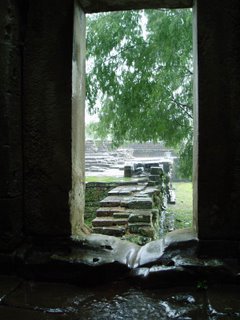
She found red spots on scraps of 68-million-year-old dinosaur bones. Turns out, paleontologist Mary Schweitzer may have uncovered blood vessels and whole blood cells in that particular T. Rex.
Her discovery is huge - overturning previous beliefs that soft tissue do no last - and stands to move the boundaries of that science a pterodactyl leap forward. Fellow paleontologists believe these observations could provide some answers to the evolution of dinosaurs, their physiology, and whether these creatures were warm or cold-blooded.
It is all in the technique – an acid bath - which is a product of Schweitzer’s unconventional approach to digging at secrets. It speaks of her background.
In many ways, that’s the most inspiring part of the story for me. And, in a not-so-subtle hint, lessons on education policies for this region.
Reports the Smithsonian (http://www.smithsonianmag.com/issues/2006/may/dinosaur.php):
“It may be that Schweitzer’s unorthodox approach to paleontology can be traced to her roundabout career path. Growing up in Helena, Montana, she went through a phase when, like many kids, she was fascinated by dinosaurs. In fact, at age 5 she announced she was going to be a paleontologist.
“But first she got a college degree in communicative disorders, married, had three children and briefly taught remedial biology to high schoolers. In 1989, a dozen years after she graduated from college, she sat in on a class at Montana State University taught by paleontologist Jack Horner, of the Museum of the Rockies, now an affiliate of the Smithsonian Institution. The lectures reignited her passion for dinosaurs. Soon after, she talked her way into a volunteer position in Horner’s lab and began to pursue a doctorate in paleontology.”
Let’s see: A kid grows up dreaming of becoming a dinosaur scientist. She follows a different path. She gets married, has three kids and becomes a high-school teacher. She goes back to school after 12 years, gets hooked on to paleontology again, volunteers in a lab and works towards her Ph.D in paleontology. Today, she’s proving that such an investment pays off.
Mary Schweitzer could only do this because in the US and many other developed countries such avenues are available. Doors remain open for the common adult to better themselves. Whether in academia, professional or vocational, adult learning programs are seen as a vital source for progress. Each field thrives on drawing people from diverse backgrounds, knowing that they bring freshness and lateral bite to a discipline.
It works on the simple principle that people constantly grow, and not stop at this threshold called Matrikulasi or STPM where their life's fate is more or less decided. Many discover (or rediscover) their passion later in life; more so in our region I believe. The sad story is, many among us buy a changkul in our 20s, dig energetically and bury our passions; partly out of security, partly because we don’t have any better means of actualization. Dulled and herded, we then go for a bite or catch a sale. Way to go.
Forget the indulgent buildings, grand highways and scenic bridges. They are paeans to raw ego and greed. The bones of a real wawasan lie in a firm commitment to education - of all ages, creed, and emphatically, race. If instead we invested heavily in setting up doors, encourage a maturing population to seize their dreams, we’d be retapping into a giga-gilawatt of human spirit.
I’ll be a happy person if, in our local institutions, we see 30-40 year olds attending undergraduate or grad courses of their choice, not just a bunch of MBA junkies. I’ll be doing flips if, in our local institutions, we see engineers taking up sculpture and accountants majoring in physics. When that happens, you know we can seriously talk about Boleh without breaking into guffaws. We needn’t be surrounded with Keranamu billboards – we’ll be living it.
Let’s not wait; let’s put together a government enlightened enough to enable that.
